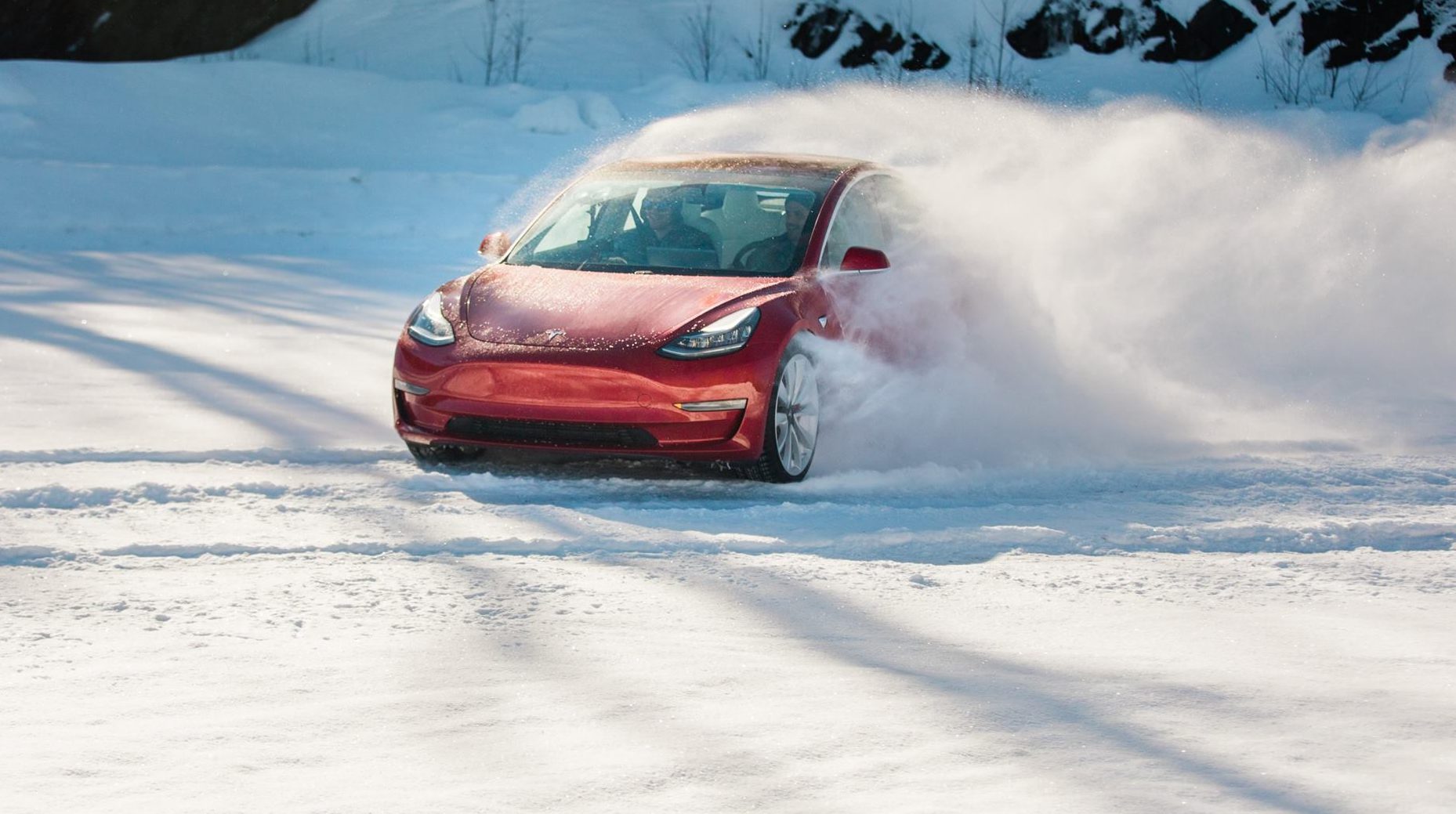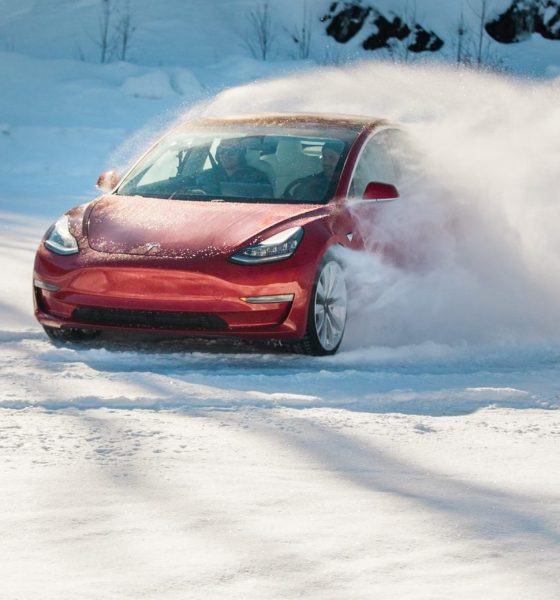

News
Tesla Model 3 impresses former rally champion after high-speed testing
After conducting high-speed tests of the Tesla Model 3 Performance and evaluating its potential as a rally car, professional driver and former champion Wyatt Knox realized that the electric sedan could be a game changer. In a conversation with Teslarati, Knox described the Model 3 Performance as a “fantastic” car, thanks to its dual motors, its Track Mode feature, and its superb handling.
Wyatt Knox, a former rally champion who currently works as the special projects director of the Team O’Neil Rally School in New Hampshire, stated that the Model 3 Performance’s dual motors are a difference-maker, allowing the electric car to “do a lot of things that a normal AWD car cannot.” It should be noted that Knox’s point of comparison in this statement is conventional rally cars, which are already frighteningly powerful in their own right. Rally cars, for one, are famed for their brutal acceleration, allowing them to reach highway speeds in unpaved terrain.
“Because of the dual motors, (the Model 3 Performance) can infinitely vary the amount of drive to the front and rear however much it is programmed to, based on your steering angle, throttle position, brake position, yaw sensor, wheel speed sensors, (and) probably more that I’m not even aware of. A Subaru or an Audi or something with one engine driving a normal transmission and center diff cannot do that,” Knox stated.

Coupled with Track Mode, which was engaged during the high-speed tests, Tesla’s dual motor system allowed for superb handling of the Model 3 Performance in the challenging, icy rally course. Referring to the car’s potential for rallying later, Knox remarked that if Tesla eventually allows owners to “tune” their vehicles by allowing them to adjust their cars’ settings, it could open up a lot of doors for the top-trim Model 3 to perform even more impressively.
“The Tesla dual motor (system) could theoretically be 100% front wheel drive, 100% rear wheel drive, or any mix of the two. That’s not how it’s really programmed to work, but that’s the tech it’s based on. That opens a LOT of really interesting doors. If you could plug in and ‘tune’ the system to your application, yeah, that would be would be a game changer,” the rally driver wrote.
Elon Musk actually mentioned a rather similar feature in an interview with YouTube tech reviewer Marques Brownlee last year. During his conversation, Musk described Track Mode’s capabilities, comparing the feature to an “expert user mode” for a computer. Musk noted that with Track Mode enabled, drivers would be able to “overclock” their electric cars’ performance.
“Track Mode will open up a lot of settings. You can adjust settings, and it’s kinda like an ‘Expert User Mode.’ You can sort of adjust traction control, adjust battery temperature. You can basically configure a bunch of things, and it will tell you, like ‘Hey, you know if you do this, it’s a bit risky. You’re gonna wear out your brakes sooner; you might blow a circuit.’ But like, it’ll be clear — like, you know, this is the risk you’re taking. It’s kinda like if you have a graphics card in a computer. You can go in there and change the settings and you can overclock things,” Musk said.

By the end of his session with the electric sedan, Knox observed that the Model 3 performed very well, especially since the vehicle’s only optimization were its Pirelli Sottozero winter tires. Despite the intensive testing sessions having been conducted in single-digit weather, Knox observed that the Model 3 Performance’s battery consumption during the tests was nominal as well.
The idea of utilizing an electric vehicle for rally events is already part of the World Rally Championship’s roadmap. Earlier this month, the WRC announced that it would be moving forward with an electric or hybrid solution from 2022. With this in mind, the sight of the Model 3 Performance ripping through the woods, in loose gravel and snow, might eventually be commonplace. For the former champion, at least, the idea of using the Model 3 Performance as a rally car is definitely a welcome thought.
The Model 3 and its Track Mode has already been proven on the track. In a recent segment, for example, Chinese auto group Know the Car tested the Model 3 Performance on the racetrack, pitting it against fellow electric cars, high-performance sedans, and supercars. The Model 3 Performance dominated in straight line acceleration in the group’s tests. In actual track tests, the Model 3 Performance proved competitive, beating similar class cars, the BMW M3 and the Mercedes-AMG C63, around the track.

News
Tesla starts showing how FSD will change lives in Europe
Local officials tested the system on narrow country roads and were impressed by FSD’s smooth, human-like driving, with some calling the service a game-changer for everyday life in areas that are far from urban centers.

Tesla has launched Europe’s first public shuttle service using Full Self-Driving (Supervised) in the rural Eifelkreis Bitburg-Prüm region of Germany, demonstrating how the technology can restore independence and mobility for people who struggle with limited transport options.
Local officials tested the system on narrow country roads and were impressed by FSD’s smooth, human-like driving, with some calling the service a game-changer for everyday life in areas that are far from urban centers.
Officials see real impact on rural residents
Arzfeld Mayor Johannes Kuhl and District Administrator Andreas Kruppert personally tested the Tesla shuttle service. This allowed them to see just how well FSD navigated winding lanes and rural roads confidently. Kruppert said, “Autonomous driving sounds like science fiction to many, but we simply see here that it works totally well in rural regions too.” Kuhl, for his part, also noted that FSD “feels like a very experienced driver.”
The pilot complements the area’s “Citizen Bus” program, which provides on-demand rides for elderly residents who can no longer drive themselves. Tesla Europe shared a video of a demonstration of the service, highlighting how FSD gives people their freedom back, even in places where public transport is not as prevalent.
What the Ministry for Economic Affairs and Transport says
Rhineland-Palatinate’s Minister Daniela Schmitt supported the project, praising the collaboration that made this “first of its kind in Europe” possible. As per the ministry, the rural rollout for the service shows FSD’s potential beyond major cities, and it delivers tangible benefits like grocery runs, doctor visits, and social connections for isolated residents.
“Reliable and flexible mobility is especially vital in rural areas. With the launch of a shuttle service using self-driving vehicles (FSD supervised) by Tesla in the Eifelkreis Bitburg-Prüm, an innovative pilot project is now getting underway that complements local community bus services. It is the first project of its kind in Europe.
“The result is a real gain for rural mobility: greater accessibility, more flexibility and tangible benefits for everyday life. A strong signal for innovation, cooperation and future-oriented mobility beyond urban centers,” the ministry wrote in a LinkedIn post.
News
Tesla China quietly posts Robotaxi-related job listing
Tesla China is currently seeking a Low Voltage Electrical Engineer to work on circuit board design for the company’s autonomous vehicles.

Tesla has posted a new job listing in Shanghai explicitly tied to its Robotaxi program, fueling speculation that the company is preparing to launch its dedicated autonomous ride-hailing service in China.
As noted in the listing, Tesla China is currently seeking a Low Voltage Electrical Engineer to work on circuit board design for the company’s autonomous vehicles.
Robotaxi-specific role
The listing, which was shared on social media platform X by industry watcher @tslaming, suggested that Tesla China is looking to fill the role urgently. The job listing itself specifically mentions that the person hired for the role will be working on the Low Voltage Hardware team, which would design the circuit boards that would serve as the nervous system of the Robotaxi.
Key tasks for the role, as indicated in the job listing, include collaboration with PCB layout, firmware, mechanical, program management, and validation teams, among other responsibilities. The role is based in Shanghai.
China Robotaxi launch
China represents a massive potential market for robotaxis, with its dense urban centers and supportive policies in select cities. Tesla has limited permission to roll out FSD in the country, though despite this, its vehicles have been hailed as among the best in the market when it comes to autonomous features. So far, at least, it appears that China supports Tesla’s FSD and Robotaxi rollout.
This was hinted at in November, when Tesla brought the Cybercab to the 8th China International Import Expo (CIIE) in Shanghai, marking the first time that the autonomous two-seater was brought to the Asia-Pacific region. The vehicle, despite not having a release date in China, received a significant amount of interest among the event’s attendees.
Elon Musk
Elon Musk and Tesla AI Director share insights after empty driver seat Robotaxi rides
The executives’ unoccupied tests hint at the rapid progress of Tesla’s unsupervised Robotaxi efforts.

Tesla CEO Elon Musk and AI Director Ashok Elluswamy celebrated Christmas Eve by sharing personal experiences with Robotaxi vehicles that had no safety monitor or occupant in the driver’s seat. Musk described the system’s “perfect driving” around Austin, while Elluswamy posted video from the back seat, calling it “an amazing experience.”
The executives’ unoccupied tests hint at the rapid progress of Tesla’s unsupervised Robotaxi efforts.
Elon and Ashok’s firsthand Robotaxi insights
Prior to Musk and the Tesla AI Director’s posts, sightings of unmanned Teslas navigating public roads were widely shared on social media. One such vehicle was spotted in Austin, Texas, which Elon Musk acknowleged by stating that “Testing is underway with no occupants in the car.”
Based on his Christmas Eve post, Musk seemed to have tested an unmanned Tesla himself. “A Tesla with no safety monitor in the car and me sitting in the passenger seat took me all around Austin on Sunday with perfect driving,” Musk wrote in his post.
Elluswamy responded with a 2-minute video showing himself in the rear of an unmanned Tesla. The video featured the vehicle’s empty front seats, as well as its smooth handling through real-world traffic. He captioned his video with the words, “It’s an amazing experience!”
Towards Unsupervised operations
During an xAI Hackathon earlier this month, Elon Musk mentioned that Tesla owed be removing Safety Monitors from its Robotaxis in Austin in just three weeks. “Unsupervised is pretty much solved at this point. So there will be Tesla Robotaxis operating in Austin with no one in them. Not even anyone in the passenger seat in about three weeks,” he said. Musk echoed similar estimates at the 2025 Annual Shareholder Meeting and the Q3 2025 earnings call.
Considering the insights that were posted Musk and Elluswamy, it does appear that Tesla is working hard towards operating its Robotaxis with no safety monitors. This is quite impressive considering that the service was launched just earlier this year.








